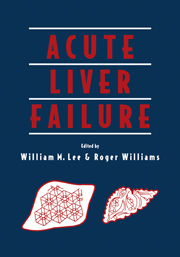Book contents
- Frontmatter
- Contents
- Preface
- Foreword
- Acknowledgments
- Contributors
- Part One Clinical Syndrome and Etiology
- Part Two Mechanisms of Disease and Multisystem Involvement
- Part Three Intensive Care Management
- 10 Medical management of acute liver failure
- 11 Circulatory derangements, monitoring, and management: heart, kidney, and brain
- 12 Brain edema and intracranial hypertension in acute liver failure
- 13 Management of infection in acute liver failure
- Part Four Transplantation
- Part Five Artificial and Bioartificial Liver Devices
- Part Six Other Applications
- Index
- Plate section
12 - Brain edema and intracranial hypertension in acute liver failure
from Part Three - Intensive Care Management
Published online by Cambridge University Press: 20 May 2010
- Frontmatter
- Contents
- Preface
- Foreword
- Acknowledgments
- Contributors
- Part One Clinical Syndrome and Etiology
- Part Two Mechanisms of Disease and Multisystem Involvement
- Part Three Intensive Care Management
- 10 Medical management of acute liver failure
- 11 Circulatory derangements, monitoring, and management: heart, kidney, and brain
- 12 Brain edema and intracranial hypertension in acute liver failure
- 13 Management of infection in acute liver failure
- Part Four Transplantation
- Part Five Artificial and Bioartificial Liver Devices
- Part Six Other Applications
- Index
- Plate section
Summary
INTRODUCTION
The development of neurological complications is a critical turning point in the course of acute liver failure (ALF). Hepatic encephalopathy can quickly progress from mild alterations of consciousness to deep coma, and intracranial hypertension as a result of brain swelling can be a major cause of death in this syndrome (O'Grady et al. 1989). At a time when liver transplantation appears as an effective therapy for patients with a low likelihood of spontaneous recovery, management of the neurological picture acquires a new urgency. The goal of this chapter is to discuss current views on the pathogenesis of brain edema, its clinicial manifestations and current therapeutic options.
HISTORY
The importance of alterations in mental state in the course of acute jaundice have been recognized since antiquity. The description of the neurological symptomatology of “acute yellow atrophy” by Frerichs in the 19th century is rich with details that are still valid today (quoted in Adams and Foley 1953). Neuropathologic descriptions of hepatic coma have lumped together the few cases of acute failure with those of cirrhosis. However, it was only in the 1940s that separation between the clinical manifestations of encephalopathy in acute liver failure from those of cirrhosis became more clearly demarcated, with delirium and convulsions a feature of acute liver disease that was seldom observed in the “quiet” evolution of coma in chronic liver failure (Greene 1940).
- Type
- Chapter
- Information
- Acute Liver Failure , pp. 144 - 157Publisher: Cambridge University PressPrint publication year: 1996
- 1
- Cited by



